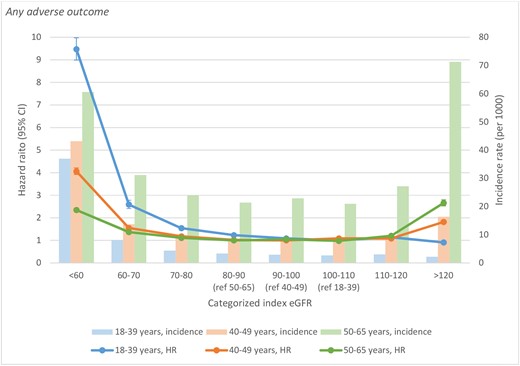-
PDF
- Split View
-
Views
-
Cite
Cite
Junayd Hussain, Nicholas Grubic, Ayub Akbari, Mark Canney, Meghan Elliott, Pietro Ravani, Peter Tanuseputro, Edward Clark, Gregory Hundemer, Tim Ramsay, Navdeep Tangri, Greg Knoll, Manish Sood, #2996 EARLY DECLINES IN KIDNEY FUNCTION AND ADVERSE OUTCOMES IN YOUNG ADULTS, Nephrology Dialysis Transplantation, Volume 38, Issue Supplement_1, June 2023, gfad063c_2996, https://doi.org/10.1093/ndt/gfad063c_2996
Close - Share Icon Share
Abstract
Whether early eGFR declines (eGFR below age-expected values) in younger adults are associated with adverse outcomes is unknown. We aim to estimate the association of an early eGFR decline with adverse outcomes by age group (18-39, 40-49, 50-65 years).
We included 8.9 million adults (aged 18-65) with ≥1 eGFR value using linked healthcare datasets in Ontario from January 2008-March 2020. The association of eGFR categories from <60 to >120 mL/min/1.73 m2 and adverse outcomes (death, cardiovascular outcomes, end-stage kidney disease) was examined using adjusted Cox models. Comparisons were relative to age normalized measured GFR categories (100-110 mL/min for 18-39, 90-100 mL/min for 40-49, 80-90 mL/min for 50-65).
The mean age, eGFR and median follow up were 41 years, 104 mL/min and 9.2 years, respectively. 17.3%, 18.9%, and 17.7% had an eGFR below normal for ages 18-39, 40-49, and 50-65, respectively. The risk of an adverse event increased in a stepwise manner with eGFR values below the referent and occurred at higher eGFR values in those 18 to 39 [eGFR 70-80, age 18-39: incidence 4.37 events per 1000 person-years[p-y], HR 1.54(1.46-1.61); age 40-49: incidence 9.78 per 1000 p-y, HR 1.18(1.15-1.21); age 50-65: incidence 24.0 per 1000 p-y, HR 1.11(1.10-1.12)] (see Figure 1). Results persisted for each outcome individually, and after using repeated eGFR, using a common referent, and adjusting for multiple covariates.
Young adults (18-39) with an early eGFR decline were at a higher risk of adverse events and this occurred at higher eGFR levels relative to middle-aged and older adults.

Incidence rates (events per 1000 person-years) and adjusted hazard ratios (HRs, 95% CI) for any adverse outcome (first of all-cause mortality, cardiovascular outcomes, end-stage kidney disease) relative to age-specific eGFR reference ranges, by age-group.





Comments